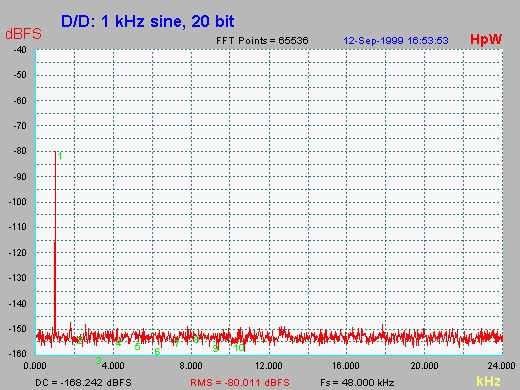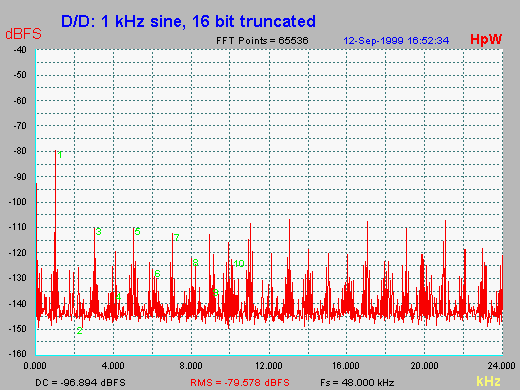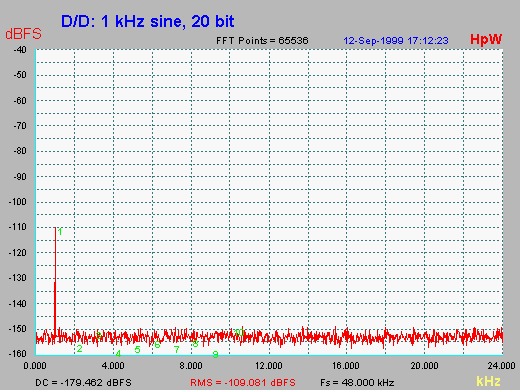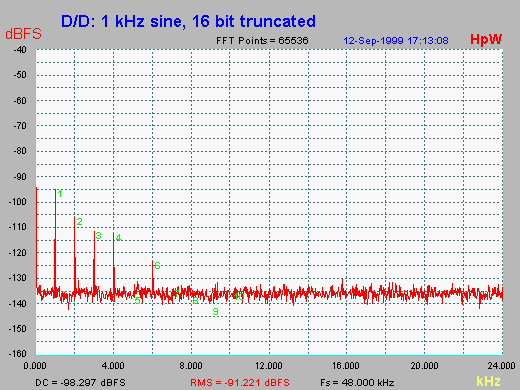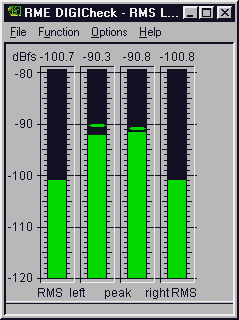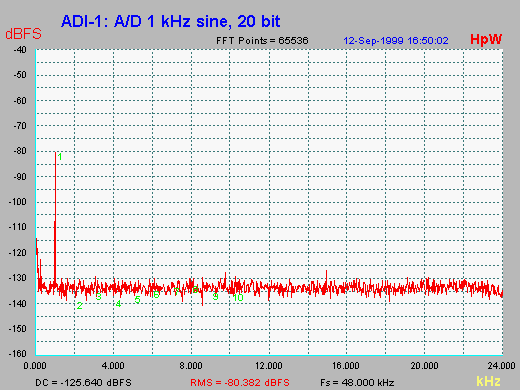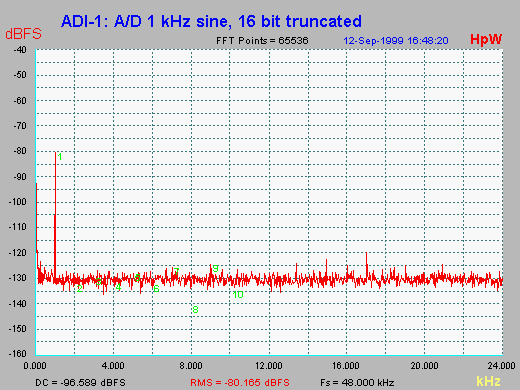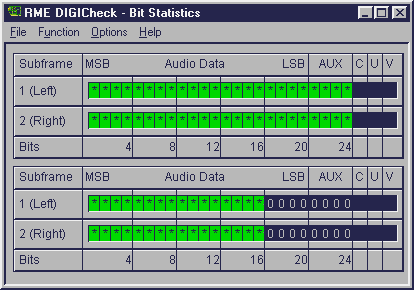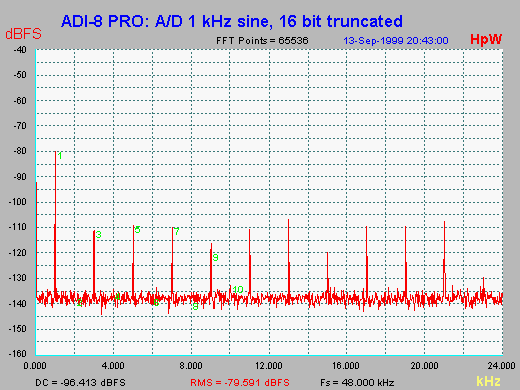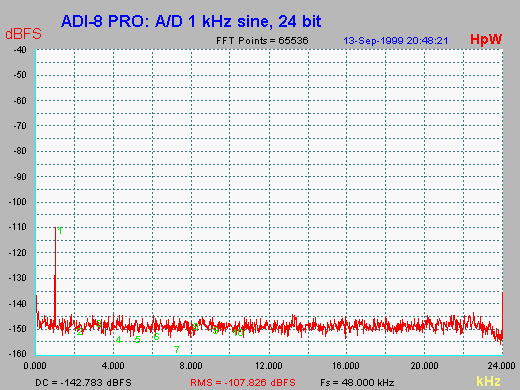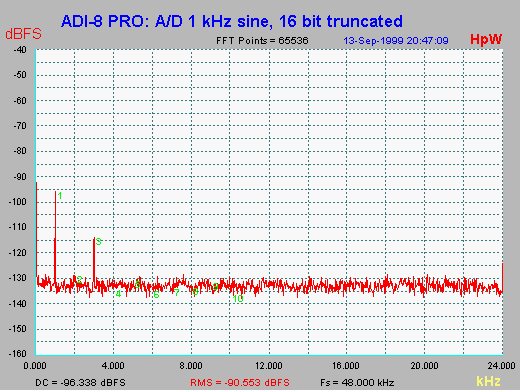 |
Dither in the ADI-1 / ADI-8 PRO
Preamble Whenever 20-bit or 24-bit digital audio is copied to a
16-bit medium (for instance), the word length is reduced by discarding the
lower bits. Truncation causes low-level components of the signal to distort.
To combat this 'quantization distortion' noise at a level corresponding
to the least-significant bit - or below - is added to the signal before
truncation, randomly modulating the signal. This process is called 'dithering'. To illustrate how dithering works fig. 1 shows a 1 kHz sine-wave at -80 dBFS. The signal has been generated digitally at 20-bit resolution, and is also analyzed at 20-bit. The FFT shows zero distortion, i.e. there are no peaks above the noise floor.
The noise floor here is a result of quantization error in the 20-bit signal. Because the resolution of any digital signal (as opposed to analogue) is finite, even 24-bit digital signals show such linearity errors. Some dither was added to the test signal by the audio generator, to smooth the noise floor a little (for presentation purposes only.) The analyzer was then set to 16-bit word length. The analyzer
truncates the digital signal (by 4 bits), leading to the result in fig.
2.
The noise floor (which used to be -152 dBFS) is now about -143 dBFS, because 16-bit quantization error is higher than 20-bit quantization error. Also, there is a slight DC offset here. The level of the 1 kHz signal itself remains unchanged at -80 dBFS. The level of the test signal (-80 dBFS) lies well within
16-bit range. We thought it might be interesting to find out what would
happen if the test signal were below the 16-bit range.
...and fig. 4 shows the results of reducing
word length to 16-bit. The sine is still present (!), but its level has
been changed to about -95 dBFS.
You might have come across similar information about digital theory before - there are several sites scattered around the Web, many of which also include practical test results. However, their purpose is often to prove that A/D converters without dither would produce horrendous distortion, and therefore sound terrible. This is actually (willful?) deceit, as truncation of a digital test signal has little or nothing in common with truncation of an A/D converter's signal, and certainly doesn't lead to such 'catastrophic' results as seen in fig. 2. This is mainly thanks to inherent noise in the converter, as can be seen in the following measurements using an ADI-1. ADI-1: Dither on chip We often get inquiries from anxious customers, asking how using a 20-bit ADI-1 as a high-quality A/D converter for a 16-bit DAT recorder could possibly be an improvement over a 16-bit one. Or - because the ADI-1 lacks dither - whether it could actually degrade the result. In a test about the ADI-1 by Sound On Sound, the author Hugh Robjohns even claimed that the ADI-1 'cannot be used as an input device for CD-R, Minidisk or DAT machines because there is no option for correct dithering down to 16 bit resolution'. Maybe he should have tried it first... All A/D converters generate noise to some degree or other.
The level of inherent noise in our ADI-1's 20-bit ADC is about -100 dBFS
(RMS unweighted), and is therefore slightly below the theoretical resolution
of a 16-bit system (rule of thumb: 16 x 6 dB = 96 dB.) On the other hand,
spikes don't count much in RMS evaluated results. Peak levels in the noise
signal are about -90 dBFS (DIGI96 owners can check both these figures using
the DIGICheck test program - see the screenshot to the right.)
The big question now: Is this 'natural dither' effect (caused
by inherent noise in an ADC) anywhere near as good as an intentionally applied,
well-defined amount of dither from an external source? The answer: It is! Fig. 6 shows a 1 kHz analogue sine converted to 20-bit digital at -80 dBFS. The noise floor level is about -134 dBFS.
Fig. 7 shows the same signal converted to 16-bit. Discarding the bottom 4 bits results in a (4 dB) higher noise floor and the same slight DC offset we saw before. The distortion level here is very low (-120 dBFS) and it only rises above the noise floor at frequencies over 12 kHz, so it is practically inaudible.
Fig. 8 shows a 1 kHz analog sine converted to 20-bit digital at -110 dBFS. Again, the noise floor level is about -134 dBFS.
Fig. 9 shows the same signal converted to 16-bit. Again, truncating the 4 least significant bits results in a (4 dB) higher noise floor and a small amount of DC offset. The signal level has shifted slightly due to the inevitable system linearity errors, but its level of -107 dB is very close to the original -110 dBFS. No distortion could be detected at all.
Conclusion Any additional dither in the ADI-1 would only push up the noise floor, and less distortion than zero is impossible. The ADI-1 is therefore an excellent substitute or companion to any devices with built-in A/D converters, such as samplers, soundcards, CD-R drives, Minidisk or DAT machines. In direct comparison to conventional 16-bit converters, the 20-bit ADI-1 wins because it can produce higher quality results while remaining completely compatible with the 16-bit format. Dither? Don't worry! ADI-8 PRO Maybe you are an ADI-8 PRO owner, and you have skipped
the ADI-1 section above? Stop!! Please go back and read the entire Tech
Info, because a lot of the above information also applies to the ADI-8. A common misconception is an 'analog' way of thinking projected
into the digital domain: Discarding the least significant bits, any low-level
components of a signal would be lost. The noise floor of a 24-bit signal
at -112 dBFS would disappear completely when converted to 16-bit, digital
zero would be the result. This is absolutely wrong. All parts of the signal
which were originally below -96 dB will still be present in the 16-bit version
(FFT proves this), but not at the original levels. In
this context you could say it is a compression-type effect - levels which
were further apart in the original have moved closer together. This state of affairs is best understood by looking at
DIGICheck's Bit Statistics page. It displays digital data in a binary form
(as 'twos complement'.)
In other words: Even with a minimum of dither (caused by 'basic' noise), the 'increased resolution' effect is retained. Of course there are some differences: The lower the dither level, the less accurate the transmission of the original level into the 16 bit signal will be. Linearity decreases, and formerly significant level changes in the region below -96 dBFS are compressed into only a few dB. Fig. 11 shows a 1 kHz analogue sine digitally recorded as 24-bit, at a level of -80 dBFS. The noise floor is about -148 dBFS.
Fig. 12 shows the result of truncating to 16-bit. As expected, the noise floor is pushed up to about -138 dBFS, and significant distortion appears across the whole frequency range. Note the distinct differences between this result and fig. 2.
The distortion you see here looks worse than it sounds.
After all, the listener's ear has to battle with a constant and relatively
high noise floor, out of which it's not only supposed to recognize the original
signal, but also the newly generated harmonics. Although the distortion
in this example is clearly audible (in case volume is pushed up enough to
also hear the noise...), the whole test as such should be put into perspective:
The A/D converter has been fed a (nearly) noise-free signal consisting of
a pure sine-wave at 1 kHz. Such signals are normally only used to test equipment
- music, speech etc. are much more complex signals which tend to mask out
most low-level distortion.
The following tests show that distortion is dynamic (and not constant as one might think) - distortion changes in level and distribution, depending on the strength of the signal. Fig. 13 shows a 1 kHz analogue sine converted to 20-bit digital at -110 dBFS. The noise floor is around -148 dBFS.
Fig. 14 shows the results of truncation to 16-bit. The noise floor is pushed up to about -138 dBFS. The distortion consists of only one inaudible harmonic. It is masked by the noise, because of its low level and proximity to the fundamental. Compare this result to the one in fig. 4.
To summarize: Audible distortion does not occur in the region below 96 dB, but only when the original signal is within the 16-bit range. The distortion depends on signal level, and is generally eliminated by noise from connected equipment and/or from the recorded signal. Apart from results from the above tests, there are other good reasons why we (and you) can safely do without dither in the ADI-8 PRO:
Summary To avoid being misunderstood here: We are not trying to
persuade you that external dither is altogether pointless. Theoretically,
the ADI-8 PRO could benefit from sophisticated dither or noise-shaping when
transferring data to 16-bit media. In reality however, DC-free converters
and limitations posed by real recording environments negate any advantages
that dither might bring.
Copyright © Matthias Carstens, 1999. RME has made every effort to ensure that all information in this document is accurate. However, we disclaim liability for any changes, errors or omissions. Changes in specifications and features of the products mentioned may be made without notice or obligation. No reproduction of this document or parts thereof, in any form, is allowed without written permission from RME. |
Copyright © 2002 RME. All rights reserved.
RME is a registered trademark. |

